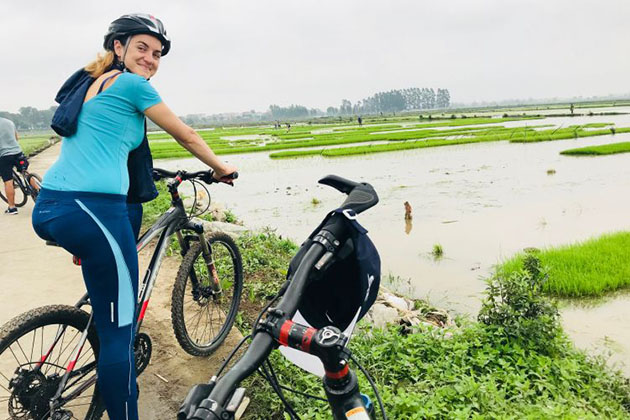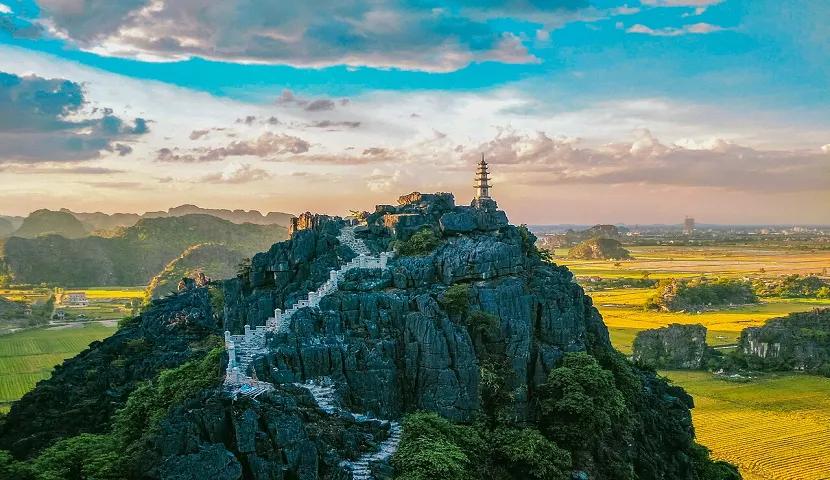.jpg)

.webp)
(10,000 reviews)
Ninh Binh is renowned for having abundant natural resources, which are conductive to tourism development, including the limestone mountains, a national park... In addition, Ninh Binh is also known for being the ancient capital of Vietnam in the 10th century, known as the first capital of the Vietnamese Monarchy.
Geological location
Ninh Binh lies to the south of the Red River Delta, which is the southern entrance to Northern part of Vietnam. At a distance of 90 km from Hanoi, Ninh Binh has the border with Ha Nam in the north, Nam Dinh in the east, Hoa Binh and Thanh Hoa in the west, and the East Sea in the south.
Some updated information in 2023
UNESCO World Heritage List
The Trang An landscape complex is recognized as a UNESCO World Heritage Site for both cultural and natural value.
What to expect in Ninh Binh
The climate in Ninh Binh is typical of the Red River Delta of northern Vietnam, very similar to that of Hanoi (link Hanoi introduction). However, due to the presence of limestone mountains, the alternative system between rivers, paddy fields and mountains, the temperature is generally cooler.
Spring in Ninh Binh normally arrives after Lunar New Year, around February with a pleasant temperature but there are also drizzles. Towards the end of March and April, the weather in Ninh Binh is especially mild, which makes outdoor trips more enchanting.
Despite the summer heat, May in Ninh Binh is really a masterpiece of nature with yellowing paddy fields. This is really a unique experience for travelers. In June and July, you can admire the beauty of the lotus flower mingling with the paddy fields and limestone rocks. It is truly a fascination! However there is to note that it is the middle of the rainy season so sometimes you will encounter quite heavy showers.
Fall is a very good time to visit all of northern Vietnam. The weather is really good with blue skies and you can also smell the scent of rice harvests.
Northern Vietnam suffers a "wet" cold in winter, but it remains bearable in urban centers.
In general, Ninh Bình is a region where you can travel almost all year round.
Breathtaking scenery
Ninh Binh is really a gift of Mother Nature to Vietnam, which has a bit of all natural resources: a national park with the very rich flora and fauna system; an 18-km coastline; the alternative scenery among the rivers and limestone mountains; many Biodiversity Reserves at the national level,... In addition to that, with about 72% of the area as a plain that favors cultivation, the endless rice fields in Ninh Binh give us a feeling of complete peace. Imagine taking a paddle boat trip or there are farmers working in the field,... it really is a rural life that one seeks.
Ninh Binh has been chosen as the place to shoot many movies, including the film "Indochina - 1992," the "Pan -2015," the "Kong: Skull island - 2017,"... for its wild and unspoiled beauty.
The home of thousand rare birds
Besides the exciting experience on the boat, visitors can also discover the wild life of nearly 40 species of birds with about 50,000 birds in Thung Nham. The Garden is most beautiful at sunset when flocks of white storks return to their nest, visitors will feel the incredible pristine beauty that is hard to find.
The great religious works
In Ninh Binh we find great religious works both in grandeur and distinctiveness. This sacred land gives us the opportunity to discover many religions found in Vietnam. Arriving in Ninh Binh, you can discover very popular religions in Vietnam:
Important land in Vietnam's history
Ninh Binh is also known as the capital of Vietnam in the 10th century, for those who love history, Hoa Lu and Tam Diep are must-see places if you want to know more about the patriotic tradition of the Vietnamese.
Cyclist's paradise
Halong Bay on the mainland and its beautiful limestone landscapes are a great excuse to cycle through the countryside. You don't need to be an expert, the terrain is flat and you can easily ride while admiring the scenery. Bicycles can delve into the maze of limestone studs, at the bottom of which are large rice fields and charming little villages. You can thus discover the typical peasant life of the Red River Delta, the cradle of Vietnamese civilization.
Bicycle rides are interspersed with visits to pagodas and temples, including the bucolic Bich Dong pagoda, built in 1428 under the Le Dynasty. The structure is a harmonious composition of three stepped pagodas on a mountainside. Thai Vi Temple, built in the 13th century, is one of the oldest Buddhist temples in Vietnam. It is distinguished by its original stone architecture that follows the principles of Eastern geomancy. On the way, you may want to stop at Ngoa Long Mountain for a nice climb to Hang Mua, the summit of which is really a lookout offering a splendid view of all of Tam Coc and the seemingly endless rice fields.

.jpg)

.webp)